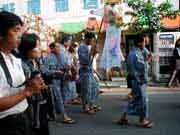Obon of the lunar calendar (Kyu Bon)
“The lunar calendar” is deeply involved with the movement of the “moon” in the nature, and this has been providing various colors to Obon and Bon Dancing.
Also, in the present, the season of Obon is “summer”, whether it is in Shichigatu Bon (Bon in July) or Hachigatsu Bon (Bon in August). But in the lunar calendar, the sense of season of Obon is rather “autumn”.
Here, we would like to see the characteristic of the Obon of the lunar calendar which every Japanese who lived before the Meiji era have experienced.
The “Honeymoon relationship” between Obon and the moon.
*The official name for the “lunar calendar” is “Taiin taiyou reki (lunar-solar calendar)”, and “Taiin” is an old Chinese word that means the “moon”.
By the way, in English they call the Taiin reki lunar calendar, and the word is also associated with the moon (Luna).
Just like its name, the lunar calendar is exactly linking with the moon which is the natural phenomenon. “Ichigatsu (first moon) (January)”,”Nigatsu (second moon) (February)” actually indicates “The first (wax and wane) of the moon of the year”, “The second moon”.
*The lunar calendar which is “the calendar of the moon” had strong relations with the labor life of the people.
Itoman City, which is located in the southern part of the main island of Okinawa, boasts a fishing industry. The culture of the lunar calendar steadfastly remains in this region even now. This is because the fishing industry which has a strong relation with the phases of the moon cannot be separated from the lunar calendar.
Thus, the lunar calendar was a necessary calendar for the agricultural production.
*Now, the relation between Obon and the moon
The point is that in “July 15th “, which is the focus of Obon in the lunar calendar, it always becomes full moon in relation with the moon which is the natural phenomena.
The spirits of the ancestors come back in Obon, and the reason why many regions adopted Hachigatsu Bon (Bon in August) is;
There is an opinion as mentioned above.
The moonlight seems to have been playing an important role in Obon.
By the way, the Lunar New Year (January 15th) is also full moon.
Obon and Bon Dancing
They danced under the moonlight of the full moon in Bon Dancing of Kyu Bon (Obon of the lunar calendar).
The moonlight was bright enough to dance, and the soft light with atmosphere had a romantic “stage effect”.
The time when the nights in Japan became brighter is no more than 50 years from now. Most Bon Dancings became a summer night event that they dance under the bright illumination, but it is still something that is exciting and fun.
The season of Obon is “autumn”.
*”The lunar calendar” which is made according to the race of the moon sometimes had gaps with the actual season (which depends on the sun). In order to compensate this phenomenon, they simultaneously used a “system of 24 seasonal divides” which they divided a year equally to 24 according to the race of the sun. (Come to think of it, there was a CM of a car that says, “A country that has 24 seasons”. That is what we are talking about.) This is why we call the lunar calendar “The lunar-solar calendar”.
July 15th of the lunar calendar which is the focus of Obon falls on “Risshu (the beginning of fall)” under the system of 24 seasonal divides, which means that autumn starts from this day. Obon in the old days was also an event to bolster the image of the turning point of the season, that is, “the end of summer and beginning of autumn”.
Obon and Bon Dancing
Among the events of Bon Dancing, there are events that make people strongly aware of “autumn”.
In Niino Anan-cho Nagano Prefecture, an event called “Odori Kami Okuri (Send the gods with a dance)” is performed in the dawn of August 16th which is the last day of Bon Dancing. This is an event that sends off the procession of Kiriko Lanterns that involve the new spirit. Since this procession is “Obon itself”, it becomes “autumn” after it passes away, and you are never allowed to dance after this.
The people who are watching the passage of the procession will literally witness the change of season from summer to autumn in front of their eyes. We may say that our ancestors who originated this kind of event are stylin’.
Send the gods with a dance

We must pay attention to the folk song called “Aki Uta (Autumn Song)” of the same Niino
After burning the Kiriko Lantern in the outskirts of the town, people return to town without looking back, and the events of Obon finishes. “Aki Uta” is sung on the way in this occasion and its contents strongly appeal that Obon is over and the autumn has come. The lyrics are nice as if seeing a picture scroll.
(It seems that autumn has come. The deer are belling, but why hasn’t the leaves turned red?)
Bonyo Bonyo-to tanoshimu uchini itsuka minishimu akino kaze
(While we enjoy Bon, saying “Bon, Bon” the cold wind of autumn comes by)
Inewa honidete choito hanakakete sarari midarete akino sora
(The white flowers of the rice plant are swinging in the wind, and it’s a beautiful sky of autumn.)
(The interpretation above may not be correct.)
Formerly, “Shiki Uta (Seasons’ songs)” of each season was sung all around Japan, but now, there are only few regions that bring it down, so Aki Uta in Niino is a valuable example.
